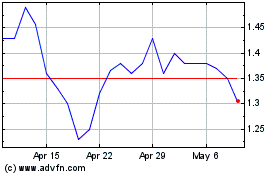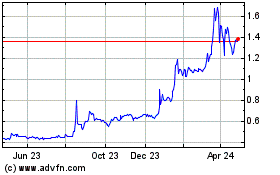Fannie, Freddie Regulator Leaves Affordable-Housing Targets Little Changed
August 19 2015 - 2:00PM
Dow Jones News
Fannie Mae's and Freddie Mac's regulator won't push the mortgage
companies to direct additional lending resources to low-income
borrowers, a blow to affordable-housing advocates.
On Wednesday, the Federal Housing Finance Agency announced new
target goals for the percentage of the mortgage companies' business
that must go to less well-off borrowers. Under the new goals, which
are effective from this year to 2017, 24% of Fannie's and Freddie's
mortgages to buy homes will be expected to go to families with
incomes no higher than 80% of their areas' median income, up one
percentage point from 2014.
Fannie and Freddie will also have the goal of directing 6% of
their home purchase loans to families with incomes that are no more
than half of their areas' median, down one percentage point from
2014.
Overall, the goals were little changed from 2014 and from what
was proposed a year ago, apart from adjustments reflecting changes
in the overall mortgage market. After an unexpected boomlet in
mortgage refinances, for example, the FHFA dropped sharply the
percentage of refinance loans that Fannie and Freddie must direct
to low-income borrowers from last year's proposal.
The goals are closely watched by affordable-housing advocates,
who see them as a means of guaranteeing that Fannie and Freddie
further mortgage access for low-income borrowers. Some critics, on
the other hand, hold the goals partly responsible for leading to
the risky lending practices that precipitated the financial
crisis.
Last year, when the proposed goals were announced, housing
advocates were disappointed. "The affordable-housing goals proposed
by FHFA fall far short of what will be needed to ensure that all
creditworthy Americans have access to mortgages," said John Taylor,
president of the National Community Reinvestment Coalition, in
response to last year's proposal. "We urge FHFA Director Mel Watt
to adopt meaningful affordable-housing goals that will ensure broad
access to conventional mortgage credit for creditworthy borrowers,
including working-class families."
In a statement on Wednesday, Mr. Watt said, "These goals
establish a solid foundation for affordable and sustainable
homeownership and rental opportunities in this country."
Fannie and Freddie don't make loans. They buy them from lenders,
wrap them into securities and provide guarantees to make investors
whole if the loans default.
Federal law requires a certain percentage of Fannie's and
Freddie's mortgage purchases to be for loans to certain kinds of
borrowers, such as to families who have an income no greater than
80% of their areas' median income. Policy makers meant the law to
ensure that Fannie and Freddie promoted mortgage access for
worse-off borrowers as part of their mission.
Since the financial crisis, some researchers have said the goals
encouraged the sort of risky lending to marginal borrowers that led
to the housing bust. However, other researchers have said that the
goals had little impact on overall mortgage availability.
After Mr. Watt, a former Democratic congressman, in January 2014
took the helm of the FHFA from acting director Ed DeMarco, many
affordable housing advocates were optimistic that he would sharply
increase Fannie's and Freddie's affordable housing benchmarks and
take other initiatives to increase mortgage access for less
creditworthy borrowers.
However, since taking the reins, Mr. Watt has taken a more
measured approach, upsetting some advocates.
For mortgage refinances to low-income borrowers, Fannie and
Freddie's goal increased one percentage point from 2014 to 21%.
Write to Joe Light at joe.light@wsj.com
Subscribe to WSJ: http://online.wsj.com?mod=djnwires
(END) Dow Jones Newswires
August 19, 2015 13:45 ET (17:45 GMT)
Copyright (c) 2015 Dow Jones & Company, Inc.
Federal Home Loan Mortgage (QB) (USOTC:FMCC)
Historical Stock Chart
From Mar 2024 to Apr 2024

Federal Home Loan Mortgage (QB) (USOTC:FMCC)
Historical Stock Chart
From Apr 2023 to Apr 2024
